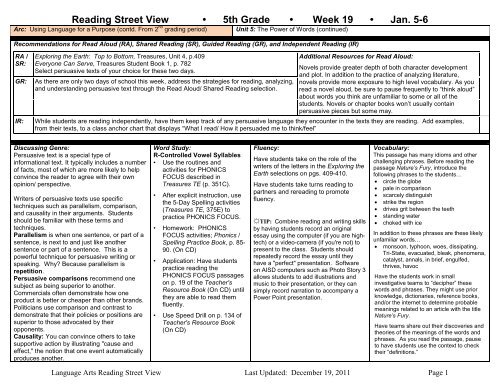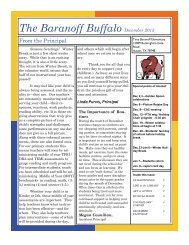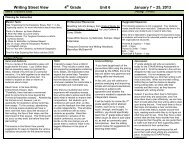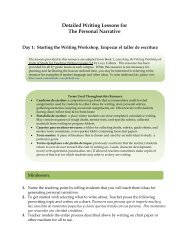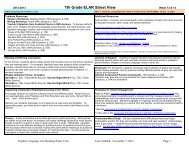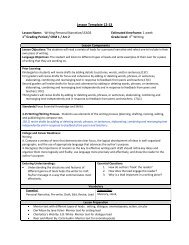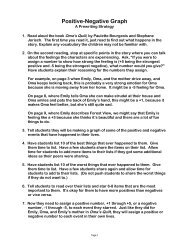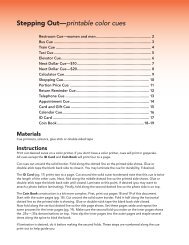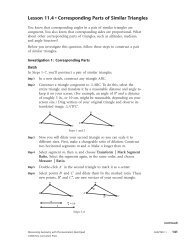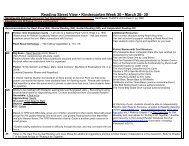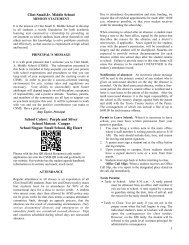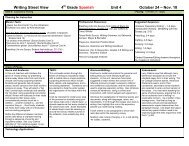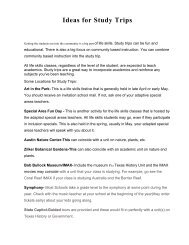Reading street view • 5th grade • week 19 • jan. 5-6
Reading street view • 5th grade • week 19 • jan. 5-6
Reading street view • 5th grade • week 19 • jan. 5-6
Create successful ePaper yourself
Turn your PDF publications into a flip-book with our unique Google optimized e-Paper software.
<strong>Reading</strong> Street View • <strong>5th</strong> Grade • Week <strong>19</strong> • Jan. 5-6Arc: Using Language for a Purpose (contd. From 2 nd grading period) Unit 5: The Power of Words (continued)Recommendations for Read Aloud (RA), Shared <strong>Reading</strong> (SR), Guided <strong>Reading</strong> (GR), and Independent <strong>Reading</strong> (IR)RA /SR:GR:IR:Exploring the Earth: Top to Bottom, Treasures, Unit 4, p.409Everyone Can Serve, Treasures Student Book 1, p. 782Select persuasive texts of your choice for these two days.As there are only two days of school this <strong>week</strong>, address the strategies for reading, analyzing,and understanding persuasive text through the Read Aloud/ Shared <strong>Reading</strong> selection.Additional Resources for Read Aloud:Novels provide greater depth of both character developmentand plot. In addition to the practice of analyzing literature,novels provide more exposure to high level vocabulary. As youread a novel aloud, be sure to pause frequently to “think aloud”about words you think are unfamiliar to some or all of thestudents. Novels or chapter books won’t usually containpersuasive pieces but some may.While students are reading independently, have them keep track of any persuasive language they encounter in the texts they are reading. Add examples,from their texts, to a class anchor chart that displays “What I read/ How it persuaded me to think/feel”Discussing Genre:Persuasive text is a special type ofinformational text. It typically includes a numberof facts, most of which are more likely to helpconvince the reader to agree with their ownopinion/ perspective.Writers of persuasive texts use specifictechniques such as parallelism, comparison,and causality in their arguments. Studentsshould be familiar with these terms andtechniques.Parallelism is when one sentence, or part of asentence, is next to and just like anothersentence or part of a sentence. This is apowerful technique for persuasive writing orspeaking. Why? Because parallelism isrepetition.Persuasive comparisons recommend onesubject as being superior to another.Commercials often demonstrate how oneproduct is better or cheaper than other brands.Politicians use comparison and contrast todemonstrate that their policies or positions aresuperior to those advocated by theiropponents.Causality: You can convince others to takesupportive action by illustrating "cause andeffect," the notion that one event automaticallyproduces another.Word Study:R-Controlled Vowel Syllables• Use the routines andactivities for PHONICSFOCUS described inTreasures TE (p. 351C).• After explicit instruction, usethe 5-Day Spelling activities(Treasures TE, 375E) topractice PHONICS FOCUS.• Homework: PHONICSFOCUS activities; Phonics /Spelling Practice Book, p. 85-90. (On CD)• Application: Have studentspractice reading thePHONICS FOCUS passageson p. <strong>19</strong> of the Teacher'sResource Book (On CD) untilthey are able to read themfluently.• Use Speed Drill on p. 134 ofTeacher's Resource Book(On CD)Fluency:Have students take on the role of thewriters of the letters in the Exploring theEarth selections on pgs. 409-410.Have students take turns reading topartners and rereading to promotefluency.☼TIP: Combine reading and writing skillsby having students record an originalessay using the computer (if you are hightech)or a video-camera (if you're not) topresent to the class. Students shouldrepeatedly record the essay until theyhave a "perfect" presentation. Softwareon AISD computers such as Photo Story 3allows students to add illustrations andmusic to their presentation, or they cansimply record narration to accompany aPower Point presentation.Vocabulary:This passage has many idioms and otherchallenging phrases. Before reading thepassage Nature’s Fury, introduce thefollowing phrases to the students…• circle the globe• pale in comparison• scarcely distinguish• strike the region• drives grit between the teeth• standing water• choked with iceIn addition to these phrases are these likelyunfamiliar words…• monsoon, typhoon, woes, dissipating,Tri-State, evacuated, bleak, phenomena,catalyst, annals, in brief, engulfed,thrives, havocHave the students work in smallinvestigative teams to “decipher” thesewords and phrases. They might use priorknowledge, dictionaries, reference books,and/or the internet to determine probablemeanings related to an article with the titleNature’s Fury.Have teams share out their discoveries andtheories of the meanings of the words andphrases. As you read the passage, pauseto have students use the context to checktheir “definitions.”Language Arts <strong>Reading</strong> Street View Last Updated: December <strong>19</strong>, 2011 Page 1
Building Comprehension:It is important for students to be aware of the language that author’s use toinfluence the reader’s thoughts and actions.When reading text to students, be sure to model the way that you determinean author’s intentions. If a text has been identified as being persuasive, itmay be helpful to locate facts and opinions in the text.Have students work with you to identify which specific words give clues thatthe author is persuading them to think or do something.Finally, have students decide if they agree with what the author is saying ornot, and state their reasons why: “The author included the advertisement onpage 469 to persuade the reader that alternative energy sources are a goodidea. I can tell the author is trying to persuade me to agree with himbecause of all the facts in the text that support this <strong>view</strong>point. He also liststestimonials of hybrid drivers. What language do you see that tells us theauthor is trying to convince us to think or do something?”See Power Point Presentation on persuasive techniques.Comprehension Skill Questions:1. What does the author want you to think about ___?2. What words is the author using to make you think that?3. How does the author use facts to support opinions?4. How does the author conclude this passage?5. Can this statement be checked and proven? What does that mean?6. What is the author trying to convince you to think/do?7. Why is the author trying to persuade you to think/do _________?8. How does the author try to convince the reader to think about _____?9. What words does the author use to influence the reader to think as he/she doesabout _________?Best Practices (ELPS, GT, Differentiation)Non-fiction sentence frames are a great way to provide support for EnglishLanguage Learners when reading an expository text. Read a few sentences at atime. Then have students complete sentence frames to show theirunderstanding of the text. For example, We depend on oil because ________.New cars can use other alternative fuels such as _______. Elaborate on orclarify students’ responses.It is important for students to be able to recognize when an author isattempting to use language in a persuasive way. Many children assume thateverything they read in non-fiction books is true. It is sometimes difficult forchildren to analyze an author’s intentions. Read aloud various smallsamplings of text. Have students decide whether an author is trying topersuade them to think or do something. Post the factual statements and thepersuasive statements in two categories for students to reference. Highlightthe language the author uses to persuade. Or you might create a web ofwords the author uses to persuade as shown in the Anchor of Supportbelow.You could also further this lesson by using this explicit instructionalsequence to re-teach students who do not understand or havemisconceptions.Anchors of Support:• Highlight key terms• “What we notice about Persuasive Writing” after reading a persuasive article.What We Notice About Persuasive Writing• States an opinion or position• Gives reasons for opinions• Backs up opinions with data, evidence, expert quotes, examples, and so on.• Offers possible solutions• Restates position in conclusionWords the authoruses to convince thereader to think or dosomethingTeacher Tips: Have students look for examples of parallelism, comparison, causality and other persuasive techniques in advertisements.Language Arts <strong>Reading</strong> Street View Last Updated: December <strong>19</strong>, 2011 Page 2
<strong>Reading</strong> Street View • <strong>5th</strong> Grade • Week 20 • Jan. 9-13Arc: Comprehension of Expository Texts/ Understanding Organizational Patterns Unit 6: Nonfiction Genre StudyRecommendations for Read Aloud (RA), Shared <strong>Reading</strong> (SR), Guided <strong>Reading</strong> (GR), and Independent <strong>Reading</strong> (IR)RA /SR:GR:IR:The Extreme Costs of Extreme Weather (Treasures, Unit 2, p. 220)Hurricanes (Treasures, Unit 2, p. 223)Shark Attack, Treasures, Unit 4, p.440A Friend Indeed, Treasures, Unit 4, p. 441Use the small group lesson guides (Treasures TE, Unit 2, p. 239N) to accompany theseleveled readers: Weather Extremes (Approaching), Weather Extremes (On Level), WeatherExtremes (Beyond Level), and Weather Extremes (ELL).* The Guided <strong>Reading</strong> Books listed above are only suggestions. Teachers should feel free to use their campusliteracy library and/or the Treasures Leveled Reader Database on ConnectEd.com as another resource to select setsof leveled books, especially for struggling students who may be reading well below <strong>5th</strong> <strong>grade</strong> level material.Additional Resources for Read Aloud:A Drop Around the World by Barbara McKinneyThe Snowflake by Neil WaldmanEvery year, the National Science Teachers Associationpublishes a wonderful list of outstanding science trade books.Teachers should browse this list for ideas, and encourage thecampus librarian to purchase appropriate books from this list.Have a variety of nonfiction texts on different topics and levels for students to read during independent reading. Model how to use two column notes to recordimportant information in texts (main ideas) in the left column and details in the right.Discussing Genre:This <strong>week</strong>’s focus is on comprehension ofNon-Fiction text. To comprehend informationaltext, it is important for students to be able tolocate important information and find the mainideas in sections of texts.Non-fiction selections are written about a topic.The topic is what the selection is mainly about.The topic is the big, general idea beingpresented to the reader. The main idea is themost important point about a topic. Details arethe facts that support the main idea.Identifying important information in exciting,well written expository text can be difficult forstudents because compelling details may grabthe imagination and lead readers astray.Students need much modeling and practice tosift, sort, and separate out important ideasfrom interesting details.Nonfiction texts are intended to provide factualinformation through text and visual images;contain ideas, facts, and principles with theprimary purpose being to communicateinformation.Word Study:Words with Final el and en• Use the routines and activities forPHONICS FOCUS described inTreasures TE (p. 387C).• After explicit instruction, use the 5-DaySpelling activities (Treasures TE,413E) to practice PHONICS FOCUS.• Homework: PHONICS FOCUSactivities; Phonics / Spelling PracticeBook, p. 91-96. (On CD)• Application: Have students practicereading the PHONICS FOCUSpassages on p. 20 of the Teacher'sResource Book (On CD) until they areable to read them fluently.• Use Speed Drill on p. 135 of Teacher'sResource Book (On CD)Fluency:Use Transparency 10 for repeatedchoral reading and paired studentpractice of an excerpt fromHurricanes. (See Treasures TE, p.235A)Students can use timers duringrepeated reading to recordincreases in reading rate.Make sure to let students know thatreading rate is not the onlycomponent of fluent reading.Students should not considerfluency practice a “race” to readfast. Model each component offluency – rate, accuracy, reading thepunctuation, pitch, tone, etc.(prosody).Vocabulary:Use the 5-Day Vocabulary activities(Treasures TE, p. 239C) to teach:damages, property, available, contact,atmosphere, destruction, surgeTake time each day to re<strong>view</strong> thesewords and use them in multiple contextsand explained in the vocabularyroutines.Language Arts <strong>Reading</strong> Street View Last Updated: December <strong>19</strong>, 2011 Page 3
Building Comprehension:Authors of informational texts often use common text structures toorganize the information. The fifth <strong>grade</strong> TEKS include the organizationalstructures of cause and effect relationships, sequential order, compareand contrast, logical order, and classification schemes. Students shouldalso use text features to locate additional information in texts. Anexample of the classification scheme might be found in an article aboutdigital media, where the author explains the differences between differenttypes of digital media (i.e. digital music, YouTube videos, interactivewebsites and games, etc.)When reading nonfiction texts, readers’ eyes catch the strikingillustrations, realistic photographs, bold headings, and telling subtitles.These features of nonfiction alert the reader to important information.These features include: fonts and special effects (titles, bold print, colorprint, italics, bullets, captions, and labels. They may also include graphics,such as diagrams, cutaways, maps, word bubbles, tables, charts, andgraphs. Students should re<strong>view</strong> and discuss text features before, duringand after reading.Comprehension Skill Questions:In addition to the stopping point questions provided in the TE, use these questions as youread with students:• What is the big idea or main idea of the paragraph/section? How do you know?• What supporting details from the text helped you to know what the paragraph/ sectionwas mostly about?• What do you think the author’s big idea was? What did the author really want you toknow about this topic?• How did the text structure and text features help you to determine the author’s messageof the article?• How did the author present the information in the text (text organization)?• Why do you think the author presented the information in this way?Differentiation:Use this text structure sort from FCRR to reinforce expository textstructure in centers or as a small group activity.Provide supports to students through instructional grouping. Considerimplementing a partner reading structure or putting students into smallcooperative groups with clearly defined roles and expectations. Givestudents comprehension questions (see above) to use as checks forunderstanding with each other.Also, since you will be printing copies of text for students, let them writenotes on the passages. Use highlighters, pencils, pens or markers so thatstudents can mark parts of the text to deepen their understanding.Anchors of Support for Independent Student Work:Anchor Chart on Text Structures:Title of Article Text Structure Used Illustration of Text StructureUsing Information from the ArticleAs students read articles with different organizational structures, have them illustrate theoverall text structure using information from the article and the images suggested in the ORSmodule on Text Structure. Add these illustrations to a class chart or individual/groupbooklets to remind students of the different types of structures.See ORS Module on Text StructureTeacher Tips: Continue to have students state the main idea of texts during and after reading throughout the year. Encourage students to justify their thinking byproviding details that support the big ideas in text. Successfully stating the main idea during and after reading is a good indicator of the level of comprehension a studenthas of the text.Language Arts <strong>Reading</strong> Street View Last Updated: December <strong>19</strong>, 2011 Page 4
<strong>Reading</strong> Street View • <strong>5th</strong> Grade • Week 21 • Jan. 17-20Arc: Drawing Conclusions in Expository/ Informational TextsUnit 6: Nonfiction Genre StudyRecommendations for Read Aloud (RA), Shared <strong>Reading</strong> (SR), Guided <strong>Reading</strong> (GR), and Independent <strong>Reading</strong> (IR)RA /SR:GR:IR:Dr. Priscilla C. Grew, Geologist (Treasures, Unit 2, p. 138) to introduce vocabularyHidden Worlds (Treasures, Unit 2, p. 140)Spirit of Endurance, Treasures, Unit 4, p. 391Use the small group lesson guides (Treasures TE, Unit 2, p. 157N) to accompany theseleveled readers: Searching for Cures (Approaching), Searching for Cures (On Level),Searching for Cures (Beyond Level), and Searching for Cures (ELL).Additional Resources for Read Aloud:The Microscope (Treasures, Read Aloud Anthology,p. 141)* The Guided <strong>Reading</strong> Books listed above are only suggestions. Teachers should feel free to use their campusliteracy library as another resource to select sets of leveled books, especially for students who may be reading wellbelow <strong>5th</strong> <strong>grade</strong> level material.Tips for Independent <strong>Reading</strong>: Students need to be surrounded by a variety of quality, accessible literature in their classrooms. When students finish a book, they need tobe able to start another book immediately! A helpful way for students to choose their next book is through the recommendation of other readers. You can help your students byproviding “book talks” periodically during Reader’s Workshop. A book talk is a very short, oral commercial that gives readers just enough information about a book to engageand interest them in reading the book. Book talks are short, usually 2 minutes or less, and give children important information about the genre, subject matter, and author. Themost important thing to convey to your students during a book talk is your enthusiasm for the book and for reading!Discussing Genre:Nonfiction texts tell about actual events, livingthings, or people. Duke (<strong>19</strong>93, 2003) makes acase for including a large amount ofinformational reading (at least 30%) inelementary age students’ reading. Nonfictionis the most frequently read kind of text outsideschools – over ninety-six percent of texts onthe Internet are expository. Informational textshelp build students’ knowledge of our world.Values of Informational Text:• Proficient reading of informational texts isrequired for school success and mostprofessions.• Many readers prefer nonfiction because itaddresses their interests and questions.Nonfiction texts are intended to provide factualinformation through text and visual images;contain ideas, facts, and principles with theprimary purpose being to communicateinformation.Word Study:Prefixes• Use the routines and activities forPHONICS FOCUS described inTreasures TE (p. 415C).• After explicit instruction, use the 5-Day Spelling activities (TreasuresTE, 437E) to practice PHONICSFOCUS.• Homework: PHONICS FOCUSactivities; Phonics / Spelling PracticeBook, p. 97-102. (On CD)• Application: Have students practicereading the PHONICS FOCUSpassages on p. 21 of the Teacher'sResource Book (On CD) until theyare able to read them fluently.• Use Speed Drill on p. 136 ofTeacher's Resource Book (On CD)Fluency:In the Transparencies booklet (on CD),use Fluency Transparency 6 forrepeated choral reading and pairedstudent practice of an excerpt fromHidden Worlds. (See Treasures TE, p.153A)Have students work in pairs repeatedlyreading the passage of text on page 50of the Practice Book (On CD) until theycan read the whole passage in 1 minuteand 30 seconds (100 words perminute). One student should readaloud while the other watches the clock(or uses a stopwatch), and then theyswap.Vocabulary:Use the 5-Day Vocabulary activities(Treasures TE, p. 157C) to teach:specimens, murky, dormant,scoured, biology, research,observer, transferred(ELL Practice Book p 33)Language Arts <strong>Reading</strong> Street View Last Updated: December <strong>19</strong>, 2011 Page 5
Building Comprehension:A quick- write is a tool you can use prior to reading that will make a difference in thecomprehension of a text. Prior to reading about a topic, students can list the related wordsand terms they know, write a paragraph discussing what they know about the topic, ormake notes about it. These actions help them activate and summarize their knowledge andanticipate what they will read about. After reading, they can go back and add to thisinformation, crossing out ideas that are not correct or do not apply to the topic and writinganother paragraph that reflects the integration of their existing and new knowledge.To infer in nonfiction texts, readers:• understand what is not stated but is implied in the text (both print and illustrations).• make conclusions that are not stated but are based on information found in the textor illustrations.• make judgments about events or theme that have not been explicitly stated.• think about the deeper meanings of text.• use background knowledge and information from the text to form theories about thesignificance of facts or events.Differentiation:Use the Treasures Visual Vocabulary Resources p. 70 – 81 to pre-teach the keyvocabulary, phrases, and basic words for the suggested reading selection to ELLstudents and others who may also benefit.(Refer to the ELL Resource Book p 33)Provide supports to students through instructional grouping. Consider implementing apartner reading structure or putting students into small cooperative groups with clearlydefined roles and expectations. Give students comprehension questions (see above)to use as checks for understanding with each other.Also, since you will be printing copies of text for students, let them write notes on thepassages. Use highlighters, pencils, pens or markers so that students can mark partsof the text to deepen their understanding.When working with ELL students, always use the ELPS to guide your planning. Usethe English/Spanish Cognates on the AISD website.Comprehension Skill Questions:In addition to the stopping point questions provided in the TE, use questions likethese as you read with students to prompt discussion on inference/drawingconclusions:• What do you already know about this subject or topic?• What did ___make you think about?• What is the author really trying to say? What in the text makes you think that?• What can you conclude (infer) about__? Where in the text…?• How can you tell that___? How do you know (background knowledge andevidence from text.• What are the ways the author presents information on this topic? How is theinformation organized?• After reading the selection, what can you conclude about…• Which sentence best shows……• How did the author show you that…?• Does the author tell us why___? What can you infer?• What was the clue in the text that helped you to figure that out?• Based on what the author has said, what can the reader tell about______?• Given what the author wrote, what do you predict will happen in the future?Anchors of Support:Anchors of support should:• make a distinction between explicit information and implied information intext (what does the author say -- what does the author mean?)• remind students to use evidence from the text to support conclusions aboutthe author’s intended message+ =Clue from What I Know My InferenceText about the clueORS Module on InferenceClues fromTextWhat it mademe thinkTeacher Tips: Inferring is the bedrock of comprehension, not only in reading but in life, too. To help students understand the nature of inferential thinking, demonstratewith facial expressions and other life examples. Inferring is about reading faces, reading body language, watching people’s actions, reading expressions, and readingtone as well as reading texts.Language Arts <strong>Reading</strong> Street View Last Updated: December <strong>19</strong>, 2011 Page 6
<strong>Reading</strong> Street View • <strong>5th</strong> Grade • Week 22 • Jan. 23-27Arc: Literary Nonfiction—Informational Text Using Literary StylesUnit 6: Nonfiction Genre StudyRecommendations for Read Aloud (RA), Shared <strong>Reading</strong> (SR), Guided <strong>Reading</strong> (GR), and Independent <strong>Reading</strong> (IR)RA /SR:GR:IR:Black Cowboy Wild Horses: A True Story (biography), Treasures, Unit 5, p. 555Through My Eyes (autobiography), Treasures, Unit 1, p. 28-31Love at First Sight (biography)When Esther Morris Headed West (biography), Treasures Student Book 2, p. 624Use the small group lesson guides (Treasures TE, Unit 5, p. 577I) to accompany theseleveled readers: Nat Love (Approaching), Alice Greenough (On Level), William F. Cody(Beyond Level), and Cowgirl: Alice Greenough (ELL).Additional Resources for Read Aloud:Deborah Sampson: Patriot Soldier Disguised as a Man (Treasures,Read Aloud Anthology, p. 60)Preventing Polio (Treasures, p. 188)Thomas Alva Edison: Inventor (Treasures, Unit 3, p. 378)The Montgolfier Brothers (Treasures, Read Aloud Anthology, p. 130)Eli Whitney by Ann GainesWilma Unlimited by Kathleen KrullHarvesting Hope by Kathleen KrullStudents can record inferences they make about subjects of biographies and autobiographies that they read during independent reading and provide evidencefrom the text to justify their conclusion.Discussing Genre:Biographies can take two forms -- theycan be a statement of facts, usually inchronological order, as would be found inan encyclopedia, or they can be morenarrative and descriptive, as may be foundin trade-books such as "Wilma Unlimited"or "Harvesting Hope."Though students are reading literarynonfiction, character traits, motivation, andchanges can be studied through thesubjects of biography and autobiography.A biographical text is written about aperson, the “subject,” by anotherperson, the “biographer.”A biographical work written by thesubject about his or her own life is anautobiography. An autobiographyusually deals with the writer’s entire lifeor a large part of it. A memoir usuallyfocuses on memories of a particulartime, event, place, or relationship.Word Study:Homophones• Use the routines and activities forPHONICS FOCUS described inTreasures TE (p. 439C).• After explicit instruction, use the 5-DaySpelling activities (Treasures TE, 449I)to practice PHONICS FOCUS.• Homework: PHONICS FOCUSactivities; Phonics / Spelling PracticeBook, p. 103-108. (On CD)• Application: Have students practicereading the PHONICS FOCUSpassages on p. 22 of the Teacher'sResource Book (On CD) until they areable to read them fluently.• Use Speed Drill on p. 137 of Teacher'sResource Book (On CD)Fluency:Use Transparency 22 for repeatedchoral reading and paired studentpractice of an excerpt from BlackCowboy Wild Horses . (See TreasuresTE, p. 573A)☼TIP: Have students practice reading aselection until they are fluent. Dividestudents into groups. Each group shouldthen divide the selection into parts witheach individual student taking one part.After taking time to practice their parts, thegroups should come back together and“perform” with each student reading athis/her respected time. If time allows,students can “compete” against othergroups for the best performance.Vocabulary:vastness, enthusiasm, horizon, ravine,presence, swerved, distinct, suspendedSee 5-Day vocabulary routines in Unit 5,pgs. 577C and 577D.Students will work with anthologies andwith morphology.They can explore the Greek root etheos,which means inspired. Then they canstudy the words enthusiasm, enthused,enthusiastic.Language Arts <strong>Reading</strong> Street View Last Updated: December <strong>19</strong>, 2011 Page 7
Building Comprehension:Use some of the following questions to support Comprehension ofBiographical text.PersonalWhat do you already know about the subject of this biography?What does the story of this person’s life make you think or wonder about?How are this person’s problems like the problems of people in otherbiographies or fiction books you have read?SettingHow important is the setting (place, time in history, and other events takingplace at that time) to the subject’s life or accomplishments?Structure or OrganizationHow did the author organize the telling of the events of the person’s life?(chronologically?)At what point in the person’s life did the author begin the biography?Literary Language and DevicesWhat literary language and devices are used in biographies andautobiographies read?How did the author use dialogue, flashbacks, foreshadowing, and otherways of organizing text to make this person’s life interesting? Are theevents depicted for the subject’s life believable and consistent with otherinformation about the time period?Best Practices (ELPS, GT, Differentiation)Explain and discuss the narrator’s point of <strong>view</strong> in Autobiography and Biography:Explain to your students that the narrator in a story is the person who tells thestory. When the narrator uses the words I, me or my to tell a story aboutsomething that happened to him or her, the story is told from the first-personpoint of <strong>view</strong>. Ask students to identify the narrator of an autobiography. Askstudents: How do you know who the narrator is? Can you prove your answer?Show me where in the story you see the use of I, me, or my? What sentencesexactly?Point out that a biography of a real person’s life is told by another person and istold from a third-person point of <strong>view</strong> (he, she, they). Have students look at abiography of an author they know and compare it with the autobiography. Havethem discuss how the biography and autobiography are alike and different.Tell students that good readers stop and ask themselves questions when theyread, such as: I notice the words, I, me, my in this selection. I wonder what kindof text I’m reading?Comprehension Skill Questions:1. Who is telling the story? How do you know?2. Where is the author?3. Does this story tell us the thoughts of all the subjects or characters or just themain character (subject)?4. What words show you that this selection is an autobiography/biography?5. Is the author of this story writing about a personal experience?6. Did _____ write this story from his/her experiences or someone else’sexperiences? How do you know?7. Is the narrator is this story speaking from personal experiences?8. How does knowing the author’s point-of-<strong>view</strong> help the reader understand thestory?Anchors of Support:You may want to use Venn Diagrams to compare subjects in biographies or autobiographies.Perspective/Point of View Chart:First person point of <strong>view</strong>: May be the main character telling the story directly; uses I and me.Third person: May be an anonymous outsider who reveals everything about the main andsupporting characters through actions, dialogue, and thoughts; uses he, she, they.Teacher Tips: Use reader’s theater to help students find the “voice” in dialogue. Having students become characters or a narrator is an excellent and enjoyable way to supportfluent reading. Biography can “come alive” when students speak as if they are the subject.Language Arts <strong>Reading</strong> Street View Last Updated: December <strong>19</strong>, 2011 Page 8
<strong>Reading</strong> Street View • <strong>5th</strong> Grade • Week 23 • Jan. 30- Feb. 3Arc: Characteristics of PoetryUnit 7: PoetryRecommendations for Read Aloud (RA), Shared <strong>Reading</strong> (SR), Guided <strong>Reading</strong> (GR), and Independent <strong>Reading</strong> (IR)RA /SR:GR:IR:Paul Revere’s Ride (excerpt) (Treasures, Unit 1, p. 120)The Mother of the Movement (Treasures, Anthology p. 82)The Circle and the Poles, Read Aloud Anthology, pgs. 101-103Mojave (Treasures, Read Aloud Anthology p. 73)Suspense (Treasures, Unit 2, p. 236)A Symphony of Trees, Read Aloud Anthology, pgs. 23-25Continue to select leveled books and high interest chapter books from your school’s LiteracyLibrary for guided reading.After the lesson, take a moment to note observations, reflect, and take anecdotal recordsabout specific students and their reading behaviors in order to plan mini-lessons and smallgroup word study.Additional Resources for Read Aloud:All But Blind (Treasures, Anthology p. 108The Circle and the Poles (Treasures, Anthology p. 101)Hot Air Balloon Haiku (Treasures, Unit 2, p. 214) [Haiku]Navajo Code Talkers (Treasures, Unit 3, p. 372) [Cinquains]Home on the Range (Treasures, Unit 5, p. 574) [Song lyrics]Shel SilversteinWhere the Sidewalk EndsFalling UpA Light in the AtticJudith ViorstIf I Were In Charge of the World and Other WorriesConfetti: Poems for Children, by Pat MoraLove That Dog, by Sharon CreechShare your love of reading with your students by doing a book talk on a book (or poem) you’re currently reading, discussing your thoughts, feelings, andconnections to the book.Discussing Genre:Poetry comes in many forms.Traditional poems and rhymes;sometimes called nursery rhymes, aremany children’s first introduction topoetry.Free verse is poetry that doesn’trhyme. Lyric poetry expressesdirect, personal emotion in a musicalor melodic manner.Narrative poetry tells a story.Limericks are one type of humorouspoetry with five lines. Lines one, two,and five having three anapestic feet,lines three and four have twoanapestic feet, in the rhyme schemeaabba.Word Study:Words with "cher" and "zher" sounds• Use the routines and activities forPHONICS FOCUS described inTreasures TE (p. 451C).• After explicit instruction, use the 5-DaySpelling activities (Treasures TE,483E) to practice PHONICS FOCUS.• Homework: PHONICS FOCUSactivities; Phonics / Spelling PracticeBook, p. 109-114. (On CD)• Application: Have students practicereading the PHONICS FOCUSpassages on p. 23 of the Teacher'sResource Book (On CD) until they areable to read them fluently.• Use Speed Drill on p. 138 of Teacher'sResource Book (On CD)Fluency:☼TIP: Model reading aloud poetry withfluency. Read the poem, The Mother ofthe Movement (Treasures TE, p. 7A)and ask the students to focus on rateand expression as you read.Slow down in sections of the poem toadd drama to your reading, and addexpression and emotion to your readingto emphasize the mood of the poem.Have students practice repeatedlyreading poems like The Mother of theMovement with the same fluency andexpression that you modeled.Vocabulary:While reading, The Mother of theMovement, be sure to stop and define thefollowing words with the students:segregation, stubborn, budging, Jim CrowEncourage students to listen to how theauthor uses word choice to set tone,mood, and emotion to influence thereader.Have students make imagery cards foreach vocabulary word. Ask them to printthe word at the top of an index card clearlyand then illustrate what the word looks likeor the tone it implies.They can also put word associations atthe bottom of the card. (For example:Stubborn mule, difficult, refuse,frustrated)Language Arts <strong>Reading</strong> Street View Last Updated: December <strong>19</strong>, 2011 Page 9
Building Comprehension:Teach students the distinction between a "literal" and a "figurative" or"metaphorical" interpretation of text. Authors often use expressions ormetaphors to convey ideas, and they do not expect their words to be takenLITERALLY. Nobody is LITERALLY "floating on a cloud" and nobody isLITERALLY "down in the dumps." Those are metaphors. Somebody couldLITERALLY spill the beans, or they could FIGURATIVELY spill the beans.Use those terms often with your students (literal, figurative, metaphorical)when reading text. Ask student things like, "Did Dr. King LITERALLY go to amountain top?" Is Rosa Parks LITERALLY the mother of the movement?Poetry is language that uses words, phrases, and sentences (andsometimes longer combinations of all) to create meaning. Poetry can benonfiction – a poem written about an outstanding individual or a heroic time,for example, writers can also publish their memoirs and autobiographies aspoetry. The important thing about poetry is how it speaks to the heart.Poetry:• supports the engagement of emotions,• evokes sensory images, lends itself to reading aloud,• incorporates rhythm and sometimes rhyme,• and captures deep meanings in very spare language from which thereader must make inferences. Poetry also offers opportunities for manyinterpretations.Differentiation:Tell students about the poems they are about to read. The Mother of theMovement is an imaginative portrait of a real person. The poems byLangston Hughes have been written to send a specific message.Explain to the students that poetry can combine literal language andfigurative language to send a specific message. Poets choose wordscarefully to set a certain mood or tone in the piece.Before reading the poems out loud, re<strong>view</strong> the vocabulary and terminologythey will see. Come up with a Define/Example/Ask routine to do this (one isnot provided by the book). Explain the meaning of each word, provide anexample of how it is used in context, and ask a question to help the studentsto make connections to the new vocabulary.Comprehension Skill Questions:1. What are the characteristics of this poem? How would you categorize it?2. What is the main message in the poem? What makes you think that?3. Why does the poet include this line ___?4. The author of the poem included __ most likely to__?5. Why were lines __ through __ included in the poem?6. Which word best describes the feeling that the poet creates in this poem?7. What is the speaker doing (thinking) in the poem?8. Why do you think the poet titled the poem __?Figurative language can be very challenging for students who have difficulty readingand understanding even the surface information in text. For interventions, have studentsrepeatedly read short passages of text that contains figurative language until the studentscan read the passage fairly fluently. THEN ask the students comprehension questionsrelated to the figurative language. While students are struggling with decoding the text,their attention is often more on reading with accuracy than reading with comprehension,but if they practice to the point of fluency, then it makes more sense to discuss theLITERAL and FIGURATIVE language in the text.Anchors of Support:Post poems in the classroom (or in a poetry notebook) labeling the forms of poem andexplaining its characteristics. Provide students with many copies of poems so they canread and reread during independent reading.Post an anchor chart on the Elements of Poetry that includes examples of figurativelanguage such as metaphor, simile, and personification.Teacher Tips: The ReadWriteThink website has a handy "Figurative Language Cheat Sheet" that students can use to support their discussions of metaphor andfigurative language.Language Arts <strong>Reading</strong> Street View Last Updated: December <strong>19</strong>, 2011 Page 10
<strong>Reading</strong> Street View • <strong>5th</strong> Grade • Week 24 • Jan. 6- 10Arc: Sensory Language in PoetryUnit 7: PoetryRecommendations for Read Aloud (RA), Shared <strong>Reading</strong> (SR), Guided <strong>Reading</strong> (GR), and Independent <strong>Reading</strong> (IR)RA /SR:GR:IR:Paul Revere’s Ride (excerpt) (Treasures, Unit 1, p. 120)The Mother of the Movement (Treasures, Anthology p. 82)The Circle and the Poles, Read Aloud Anthology, pgs. 101-103Mojave (Treasures, Read Aloud Anthology p. 73)Suspense (Treasures, Unit 2, p. 236)A Symphony of Trees, Read Aloud Anthology, pgs. 23-25Continue to select leveled books and high interest chapter books from your school’s LiteracyLibrary for guided reading.After the lesson, take a moment to note observations, reflect, and take anecdotal recordsabout specific students and their reading behaviors in order to plan mini-lessons and smallgroup word study.Additional Resources for Read Aloud:The Microscope (Treasures, Read Aloud Anthology, p. 141)[The poem Mojave is also published as a beautiful picturebook.]Shel SilversteinWhere the Sidewalk EndsFalling UpA Light in the AtticJudith ViorstIf I Were In Charge of the World and Other WorriesConfetti: Poems for Children, by Pat MoraLove That Dog, by Sharon CreechGive your library time the purpose it deserves by making it a time to conference with individual students about book selection. This is a great time for you to check up on whatthey are choosing, and to suggest books they might enjoy. Teach students to utilize the school librarian, you, and their classmates as resources for finding books they’ll love.Discussing Genre:Writing poetry involves the use of imagery.Authors utilize sensory language to helpthe readers create images and feelings inresponse to their writing. Sensorylanguage is when the author uses wordsand details that appeal to the reader’ssenses (sight, sound, taste, touch, smell).Poetry is a concentrated blend of soundand imagery intended to create anemotional response.• Poetry is characterized by rhythmicalpattern of language, such assyllabification, rhyme, rhythm,alliteration, and onomatopoeia.• Poetry is read, heard, and enjoyedthrough the effects of figurativelanguage, literary elements, andsound devices.• Figurative language of poetry includessimile, metaphor, personification,hyperbole, and idioms.Poetry is the most condensed andconcentrated form of literatureWord Study:Words that end with ance and ence• Use the routines and activities forPHONICS FOCUS described inTreasures TE (p. 485C).• After explicit instruction, use the 5-Day Spelling activities (TreasuresTE, 513E) to practice PHONICSFOCUS.• Homework: PHONICS FOCUSactivities; Phonics / Spelling PracticeBook, p. 115-120. (On CD)• Application: Have students practicereading the PHONICS FOCUSpassages on p. 24 of the Teacher'sResource Book (On CD) until theyare able to read them fluently.• Use Speed Drill on p. 139 ofTeacher's Resource Book (On CD)Fluency:<strong>Reading</strong> poetry is a fun way to increasereading fluency because poems haverhythm and expression. They workparticularly well for echo and choral reading.1) Read the book or poem aloud to yourstudents several times while students arefollowing along.2) Read the poem through, line by line,doing an echo read, where you read a lineand then your students read the same line.3) Choral read the poem together.4) Your students now read the poem on theirown. Students re-read the same poem overagain until they can read with goodexpression and at an acceptable pace. It canbe fun and motivating for the child if you nowrecord him reading the poem.5) Students should each have a poetryfolder with a collection of poems – oneintroduced per <strong>week</strong> over the school year.Vocabulary:Types of Figurative Language include:• Imagery• Simile• Metaphor• Alliteration• Personification• Onomatopoeia• Hyperbole• IdiomsDefinitions can be found here!Palindrome – Palindromes are words orphrases that read the same in bothdirections, e.g. EYE,or RACECAR, orMADAM I'M ADAM.Tongue Twister –is a phrase that isdesigned to be difficult to articulateproperly. Tongue-twisters may rely onsimilar but distinct phonemesRiddle - is a statement or question orphrase having a double or veiled meaning,put forth as a puzzle to be solvedLanguage Arts <strong>Reading</strong> Street View Last Updated: December <strong>19</strong>, 2011 Page 11
Building Comprehension:When explaining to your students what figurative language is, it is importantto start with a working definition of literal language. Literal language refers toa phrase or sentence that is to be taken at face value to mean exactly what itsays. For example, if a sentence reads, "He went outside the box," thatmeans the man was in a box and went outside of that area to another space.Figurative language means using words to imply another meaning or toevoke an emotion. Going back to the previous example, "He went outsidethe box," the sentence would have a whole different meaning if takenfiguratively. By interpreting "He went outside the box," figuratively, thesentence means that the person used his imagination and creativity to solvea problem. So, the same sentence can have completely different meaningswhen taken either literally or figuratively.Comprehension Skill Questions:1. What are the characteristics of this poem? How would you categorize it?2. What is the main message in the poem? What makes you think that?3. Why does the poet include this line ___?4. The author of the poem included __ most likely to__?5. Why were lines __ through __ included in the poem?6. Which word best describes the feeling that the poet creates in this poem?7. What is the speaker doing (thinking) in the poem?8. Why do you think the poet titled the poem __?Differentiation:This lesson http://betterlesson.com/lesson/7944/sensory-image providesanother instructional routine for teaching sensory images. It includessuggestion for read aloud, alternate poems, graphic organizers and a powerpoint presentation.Select a graphic organizer that you will use for sensory imagery throughoutthe <strong>week</strong>. Create an anchor chart with this graphic organizer for students torefer to and have copies of the graphic organizer available as an instructionalaide.English Language Proficiency StandardsAnchors of Support:Post poems in the classroom (or in a poetry notebook) labeling the forms of poem andexplaining its characteristics. Provide students with many copies of poems so they canread and reread during independent reading.Post an anchor chart on the Elements of Poetry that includes examples of figurativelanguage such as metaphor, simile, and personification.Another anchor for figurative language:WORDORPHRASEPAGE INBOOKLITERALMEANINGFIGURATIVEMEANING(Meaning in theStory or poem)Teacher Tips: Engage the whole class in choral reading of poems and longer texts. Encourage students to use their voices as instruments to convey their interpretationof the text. Often, they will need to discuss the meaning and come to a group decision about which words to stress and how to phrase the reading in poems.Language Arts <strong>Reading</strong> Street View Last Updated: December <strong>19</strong>, 2011 Page 12
<strong>Reading</strong> Street View • <strong>5th</strong> Grade • Week 25 • Feb. 13-16Arc Focus: MoY TestingUnit: MoY TestMOY II TESTING THIS WEEKNO NEW CONCEPTS INTRODUCEDContinue to teach the following skill as time allows during this <strong>week</strong>:Poetry (Arc 23 and 24)IRDuring independent reading students should continue reading familiar texts, poems, and texts that are on their appropriate reading level. It may be a goodidea to provide poetry anthologies or copies of poems for students to select during independent reading.Language Arts <strong>Reading</strong> Street View Last Updated: December <strong>19</strong>, 2011 Page 13
<strong>Reading</strong> Street View • <strong>5th</strong> Grade • Week 26 • Feb. 21-24Arc: Summary of Fiction: DramaUnit 8: Re<strong>view</strong> of SummarizationRecommendations for Read Aloud (RA), Shared <strong>Reading</strong> (SR), Guided <strong>Reading</strong> (GR), and Independent <strong>Reading</strong> (IR)RA /SR:GR:Anansi and Common Sense, Treasures, Unit 3, pgs. 252-253The Catch of the Day: A Trickster Play, Treasures, Unit 3, pgs. 255-270This would be a good <strong>week</strong> to use reader’s theater scripts during small group instruction.Students can work both on the comprehension skills of the <strong>week</strong> as well as practicefluent reading.Additional Resources for Read Aloud:Online Plays for ChildrenReader’s Theater ScriptsThe Treasures Read Aloud Anthology has several plays you mayuse.IR:By now your students should be independently seeking out books appropriate to their independent reading levels and interests. For students who seem resistant to adoptingreading as a personal past time, don’t give up on this crucial piece of instruction. Continue to offer reluctant readers books that vary by genre, subject, theme, style, and form.Insist that they read at least one chapter to see if it’s a fit. Consider the student’s other activities and personal interests to help guide you. Ask the student what types of texthe/she would enjoy reading most. Try pairing the student with an enthusiastic, friendly reader for partner reading (same books). Keep trying to find that “in” that will get evenyour reluctant readers hooked on reading.Discussing Genre:<strong>Reading</strong> drama is very different from otherfiction and nonfiction genres, though it canfall into both categories. Thecomprehension foci this <strong>week</strong> is onsummarizing plot, roles and functions ofcharacters (as well as relationships andconflict). An additional focus is point of<strong>view</strong>. These can all be taught throughdrama. .Building fluency is one of the five majordictates set up in <strong>Reading</strong> First, part of theNo Child Left Behind Act. Put <strong>Reading</strong>First, a booklet published by the U.S.Department of Education et al (2001),states that "Readers' theatre providesreaders with a legitimate reason to rereadtext and to practice fluency. Readers’theatre also promotes cooperativeinteraction with peers and makes thereading task appealing."If you want to get your kids reading withcomprehension, expression, fluency, andjoy, Reader’s Theater is an excellentinstructional strategy.Word Study:Suffixes• Use the routines and activities forPHONICS FOCUS described inTreasures TE (p. 525C).• After explicit instruction, use the 5-DaySpelling activities (Treasures TE,549E) to practice PHONICS FOCUS.• Homework: PHONICS FOCUSactivities; Phonics / Spelling PracticeBook, p. 121-126. (On CD)• Application: Have students practicereading the PHONICS FOCUSpassages on p. 25 of the Teacher'sResource Book (On CD) until they areable to read them fluently.• Use Speed Drill on p. 140 of Teacher'sResource Book (On CD)Fluency:Use Transparency 11 for repeatedchoral reading and paired studentpractice of an excerpt from Catch of theDay: A Trickster Play. (See TreasuresTE, p. 273A)☼TIP: Poetry Slam: For several <strong>week</strong>s,poetry has been mentioned as a way tohelp students with their fluency. Compileall of the poems that you have beenpracticing into folders for each of yourstudents, and have students select a fewpoems for a Poetry Slam. Have studentspractice their poem recital with fluencyand attitude -- a Poetry Slam is all aboutattitude and presentation. (Lots of greatvideos of Poetry Slams are available onthe internet: search for "High SchoolPoetry Slam" for videos to show yourstudents.)Vocabulary:wares, treasurer, merchandise, instruct,burden, educate, appreciation,unfortunateSee the 5-Day Robust Vocabularyroutines in Treasures, Unit 3, pgs.277C-277D.Language Arts <strong>Reading</strong> Street View Last Updated: December <strong>19</strong>, 2011 Page 14
Building Comprehension:Through both improvised, script reading (Reader’s Theater) and moreformal, memorized performances, students can explore the nature of story,learn about life, and empathize with other people. Dramatic performanceenables students to enjoy literature and poetry in an active, participatoryway. The language continues to “live” in their minds and is a resource fortheir own writing as they try out new ways of using written language.Performances also enhance vocabulary, fluency, and team work.In process drama the teacher and students take on the roles of charactersfrom their literature study and enter into an imagined world that is stronglyguided by their interpretation of the text. Process drama leads students intoan aesthetic experience because it places the reader in the story – as if it ishappening now. Process drama brings the act of ongoing construction ofmeaning into full <strong>view</strong> and builds deeper comprehension about characters,plot, and the whole story.Comprehension Skill Questions:• How does the author reveal the character in the play (dialogue, actions, etc.)• What is the main conflict between ___?• What clues does the author give us to help us predict __(foreshadowing)?• What are the most important events?• How does the setting (time and place) contribute to the story?• What two or three sentences summarizes the whole story?• What is the author’s message?• Who tells the story? Is this the best person to tell it? Why?• How would you retell the story in a few sentences?Differentiation:You may need to explicitly teach the unique features of drama:• Dramas are written in a special form called a script. The script contains alist of characters, the lines the characters say, and the stage directions.• A play is usually divided into parts called ‘acts’, and each act is divided intodifferent ‘scenes’. A scene is usually one event in the story.• Some plays have a narrator who gives the audience information about whatis happening in the play.• The characters’ names appear before the lines of text they speak.• Stage directions tell the characters where to go on the stage, how to move,and how to say their lines.Anchors of Support:Use the same graphic organizer you used to summarize other narrative texts to write asummary for a drama:• Story Arc/Story Map• Somebody Wanted/Needed But So Then• Story ElementsStrategy for Narrative Summary:-Somebody (identify the character(s)-Wanted (describe the character’s goal)-But (describe a conflict that hinders the character)-So (describe how the character reacts to the conflict)-Then (describe the resolution of the conflict)*Remember to focus on information that is mostsignificant.Have students summarize the main ideas of each scene. The STAAR is now askingstudents to summarize parts of a text, including a scene within a drama.Teacher Tips: Favorite children’s picture books that contain dialogue can easily be adapted into reader’s theater plays. This can be an excellent extension activity foryour high level readers.Language Arts <strong>Reading</strong> Street View Last Updated: December <strong>19</strong>, 2011 Page 15
<strong>Reading</strong> Street View • <strong>5th</strong> Grade • Week 27 • Feb. 27- March 2Arc: Determining the Main Ideas to Summarize NonfictionUnit 8: Re<strong>view</strong> of SummarizationRecommendations for Read Aloud (RA), Shared <strong>Reading</strong> (SR), Guided <strong>Reading</strong> (GR), and Independent <strong>Reading</strong> (IR)RA /SR:GR:Jobs in Space (Treasures, Unit 4, p. 416)Ultimate Field Trip 5: Blasting Off to Space Academy (Treasures, Unit 4, p. 418)Use the small group lesson guides (Treasures TE, Unit 4, p. 413N) to accompany theseleveled readers: Science in the Snow (Approaching), Science in the Snow (On Level),Science in the Snow (Beyond Level), and Science at the North and South Poles (ELL).Additional Resources for Read Aloud:Choose from the nonfiction selections in the Time for Kidsmagazine.IR:* The Guided <strong>Reading</strong> Books listed above are only suggestions. Teachers should feel free to use their campusliteracy library and/or the Treasures Leveled Reader Database on ConnectEd.com as another resource to select setsof leveled books, especially for struggling students who may be reading well below <strong>5th</strong> <strong>grade</strong> level material.This <strong>week</strong> it will be important that students select an expository text for independent reading so they can practice determining the main idea of sections. Havestudents respond to the texts they read independently this <strong>week</strong> in multiple ways, such as graphic organizers, such as T-charts recording main idea andsupporting details, as well as by responding in their Reader Response Journal with connections, questions, and observations.Discussing Genre:Determining important ideas and informationin nonfiction text is central to making sense ofreading and moving toward insight. Whenstudents read nonfiction, they can be taughtover<strong>view</strong>ing, a form of skimming andscanning the text before reading. This helpswith:• Activating prior knowledge• Noting characteristics of text length andstructure• Noting important headings andsubheadings• Determining what to read and in whatorder• Determining what to pay careful attentionto• Deciding to quit if the text contains norelevant information• Deciding if the text is worth careful readingor just skimmingA careful over<strong>view</strong> saves precious time forstudents when reading difficult nonfictiontexts. The ability to over<strong>view</strong> eliminates theneed for students to read everything whensearching for specific information.Word Study:Homophones• Use the routines and activities forPHONICS FOCUS described inTreasures TE (p. 551C).• After explicit instruction, use the 5-Day Spelling activities (TreasuresTE, 577E) to practice PHONICSFOCUS.• Homework: PHONICS FOCUSactivities; Phonics / SpellingPractice Book, p. 127-132. (On CD)• Application: Have students practicereading the PHONICS FOCUSpassages on p. 26 of the Teacher'sResource Book (On CD) until theyare able to read them fluently.• Use Speed Drill on p. 141 ofTeacher's Resource Book (On CD)Fluency:Use Transparency 16 for repeatedchoral reading and paired studentpractice of an excerpt from Spirit ofEndurance. (See Treasures TE, p.407A)Students should practice reading witha partner. Each partner should take aturn reading aloud while the otherstudent keeps track of reading timeand errors. Each student should readthe passage at least 4 times, and bythe 4th reading, students should bereading over 120 words per minutewith good expression and appropriatephrasing.Vocabulary:Use the 5-Day Vocabulary activities(Treasures TE, p. 413C) to teach:frigid, treacherous, triumph, uninhabited,expedition, labor, dismantled, abandonLanguage Arts <strong>Reading</strong> Street View Last Updated: December <strong>19</strong>, 2011 Page 16
Building Comprehension:As adults, we summarize on a regular basis. We summarize books and newsarticles we’ve read; we summarize movies and television programs we’vewatched; we summarize conversations we’ve had and experiences we’ve had.Therefore, we can cite many real-world reasons why it is important for children todevelop this skill, beginning with short texts.This <strong>week</strong> we explore summary for non-fiction texts. Remind students thatsummary is processing and understanding the information we read and thedeeper message found in it. Summary is not simply recounting facts, butcapturing the essence of the text. It also involves retelling the events in the orderthey occurred, in a way that maintains meaning.Students must learn that the summaries of narrative and expository text aredifferent. While narrative summaries touch upon the important literary elementsand events in a story, expository summaries are much more formal, including theanswers to the “reporter’s questions”: Who, What, When, Where, Why, andsometimes How. This reporting strategy is used to help students understandsummarization of nonfiction text, and can be used both during and after reading.The following link provides an alternative way to write an expository summary:Super Summary, pgs.25-28 NF Summary – Combining Main Ideas. If youchoose to use this graphic organizer, be sure students understand the differencebetween main idea and summary.Comprehension Skill Questions:• What is this section mainly about?• What is the author mainly telling us about in these paragraphs/in this section?• This article (section) is mostly about —• What are the details that support what this paragraph is mainly about?• When reading this, what sticks out to you the most? Why?• How can you summarize the information that the author presents in this portion of thetext?• What idea do those facts help support?• What is the main idea of this information?• What are the four most important facts in this information?Differentiation:To scaffold creating a non-fiction summary for students, break the text intosmaller chunks. Then use gestures or illustrations to convey the meaning ofthe chunk from the passage. Ask students to orally summarize the text asyou go through, putting the ideas together into a coherent summary.Make sure students understand all difficult vocabulary within the text they arereading, before they begin to write a summary.English Language Proficiency StandardsAnchors of Support for Independent Student Work:Anchors of support should remind students that a summary includes only importantinformation about the topic. Remind students that in expository text, the purpose forreading is to learn information about a certain topic. The following questions will helpstudents to determine what information to include in their summary.Strategy for Expository Summary:-Who/What is the passage mostly about?(topic or subject)-What is important about the topic orsubject?-When does this take place?-Where does this take place?-Why is the topic or subject important?-How does this occur?Teacher Tips: Identifying the main idea is a complex skill that is built over time. Continue to provide additional reading material and ample opportunities for students topractice finding the main idea during the remainder of the year.Language Arts <strong>Reading</strong> Street View Last Updated: December <strong>19</strong>, 2011 Page 17
<strong>Reading</strong> Street View • <strong>5th</strong> Grade • Weeks 28 & 29 • March 5-9, <strong>19</strong>-23Arc: Comparing and Contrasting Across TextsUnit 9: Connections Across TextsRecommendations for Read Aloud (RA), Shared <strong>Reading</strong> (SR), Guided <strong>Reading</strong> (GR), and Independent <strong>Reading</strong> (IR)RA /SR:GR:A Boy Named Abe (Treasures, Anthology, p. 147)A Move West, Treasures, Unit 5, p. 526/Valley of the Moon, p. 529/The Settlement of theWest, p. 544Toward Freedom (Treasures, Unit 1, p. 62)/Honoring Freedom, Time For Kids, p. 22/Maya Lin: Architect of Memory (Treasures, Unit 1, p. 64)Use the small group lesson guides (Treasures TE, Unit 4, p. 549I) to accompany theseleveled readers: Westward Ho (Approaching-Level R), Westward Ho (On Level - U),Westward Ho (Beyond Level - X), and Westward Ho (ELL – level R).Additional Textbook Resources for Read Paired Selections:• Going Someplace Special/Through My Eyes, Treasures, Unit 1,pgs. 11-31 and I, Too (Langston Hughes poem), Time for Kids,p.12/Equal Rights for All, Time for Kids, p.78• Shiloh/Love at First Sight, Treasures, Unit 1, pgs. 39-57• Are We Killing the Oceans?/Our Packed Planet, Time for Kids,pgs. 110-115IR:This is the time of year when Independent <strong>Reading</strong> time gets SQUEEZED out of your day. Don’t lose this valuable time in your classroom. Research proves thatchildren who spend more time reading on a daily basis do better on academic tests! Continue to make time for a silent reading block of time in your daily schedule. It’llreap its rewards for you and your students in the end!Discussing Genre:Folk Tales are very common onstate tests for fifth <strong>grade</strong>rs. Takingsome time to explore andunderstand the Genre of Folktaleswill help fifth <strong>grade</strong>rs be morecomfortable with the uniquequalities of this genre including:-Folktales often have a message orlesson for readers.-Some folktales tell about familiarthings and events that couldhappen in real life.-Many folktales have a trickster asthe main character.Word Study:Prefixes• Use the routines and activities for PHONICSFOCUS described in Treasures TE (p. 579C).• After explicit instruction, use the 5-Day Spellingactivities (Treasures TE, 589I) to practicePHONICS FOCUS.• Homework: PHONICS FOCUS activities; Phonics/ Spelling Practice Book, p. 133-138. (On CD)• Application: Have students practice reading thePHONICS FOCUS passages on p. 27 of theTeacher's Resource Book (On CD) until they areable to read them fluently.• Use Speed Drill on p. 142 of Teacher's ResourceBook (On CD) PHONICS FOCUS.• Homework: PHONICS FOCUS activities; Phonics/ Spelling Practice Book, p. 145-150. (On CD)• Application: Have students practice reading thePHONICS FOCUS passages on p. 29 of theTeacher's Resource Book (On CD) until they areable to read them fluently.• Use Speed Drill on p. 144 of Teacher's ResourceBook (On CD)Fluency:Use Transparency 21 for repeatedchoral reading and paired studentpractice of an excerpt from Valley ofthe Moon (See Treasures TE, p.543A)Students should practice reading witha partner. Each partner should take aturn reading aloud while the otherstudent keeps track of reading timeand errors. Each student should readthe passage at least 4 times, and bythe 4th reading, students should bereading over 120 words per minutewith good expression and appropriatephrasing.Vocabulary:Use the 5-Day Vocabulary activities(Treasures TE, p. 549C) to teach:refuge, obvious, ignored, detested,obedience, depicts, eldest>|< REFLECT: On the Road toSuccess: Returning from SpringBreak is a great time to reflect on all ofthe vocabulary the students havelearned this year. If you have madevocabulary instruction a central featurein your classroom, then the studentshave likely learned hundreds of wordsby now. Show the students how muchthey have learned by having themcreate a "trail" of cards, each cardcontaining a vocabulary word theylearned in your class. Stretch thecards down the longest hallway in yourschool and tell the students that this istheir "pathway" to college and asuccessful life.Language Arts <strong>Reading</strong> Street View Last Updated: December <strong>19</strong>, 2011 Page 18
Building Comprehension:Whether it is connecting to the movies that we watch, connecting to others, orconnecting to the texts that we read, making connections is a natural processthat comes easily to most of us. In teaching, the challenge lies in making ourthinking explicit when we make connections, and teaching our students how toidentify when they are making those connections.In their book, Strategies that Work, Stephanie Harvey and Anne Goudvis state:Generally, kids start by making text-to-text connections to more obviouselements of stories, such as characters or problems. Some text-to-textconnections, in order of increasing sophistication, might include:Comparing characters, their personalities, and actionsComparing story events and plot linesComparing lessons, themes, or messages in storiesComparing themes, ideas, issues in fiction/nonfiction text pairsFinding common themes, writing style, or perspectives in the work of asingle authorComparing the treatment of common themes by different authorsComparing different versions of familiar storiesBest Practices (ELPS, GT, Differentiation)Help ELL students by starting with concrete examples and moving to abstract.Ask two students to stand up at the front of the classroom. Begin comparing theirsimilarities and differences: (ELPS 1C-Learning Strategies)Raquel is wearing a purple shirt, Jose is wearing an orange shirt.Raquel is taller than Jose.Both Jose and Raquel have brown hair.Then have the class vote on their two favorite movies. Have students compare andcontrast the two movies. Begin to use the sentence stems that students may see onstate assessments:How were characters same or different?How were the settings the same or different?One way that both movies were the same is….One way that Movie 1 was different from Movie 2 is…..Use this example to help ELL students understand how they will be asked tocompare and contrast stories on the STAAR test.Comprehension Skill Questions:•An idea present in both selections is –• One concept that is important in ___ but not in ___ is that of –•The difference between the article and the story is that the story –•A similarity between these two selections is that both discuss –•How are the stories alike?• What do the selections have in common?•What is a common theme found in both selections?Anchors of Support:Use T-charts for this <strong>week</strong>’s graphic organizer. Tests sometimes use Venn Diagramsand T-charts to compare things.Have students build the diagram with you by using sentence strips and hula hoops,then manipulate the sentence strips to match up similar things (characters at the top,theme second, setting third etc.)English Language Proficiency StandardsTeacher Tips: Comparing and Contrasting does not have to be limited to Language Arts. Bringing up comparing and contrasting during Science is an excellent way toreinforce this skill. Comparing animal’s adaptations, ecosystems and environments will help students understand how to closely examine things. Using a Venn Diagramor T-chart during Science would help ELL students understand and be more comfortable with the graphic organizers and making comparisons across texts.Language Arts <strong>Reading</strong> Street View Last Updated: December <strong>19</strong>, 2011 Page <strong>19</strong>


